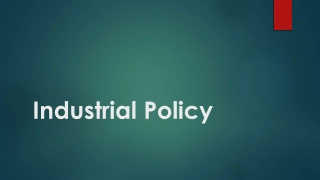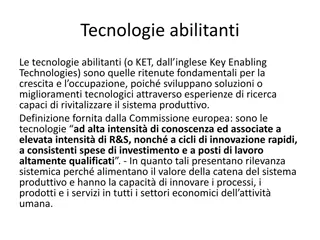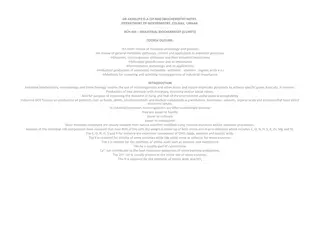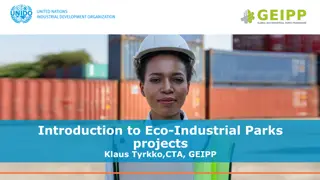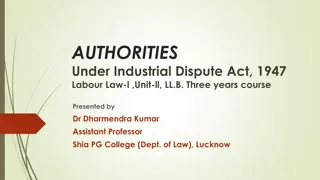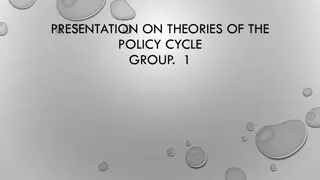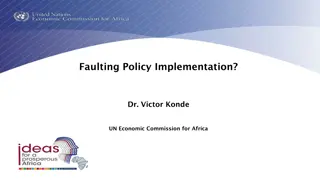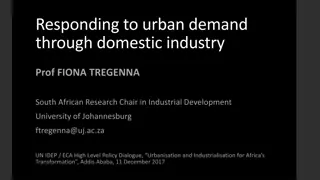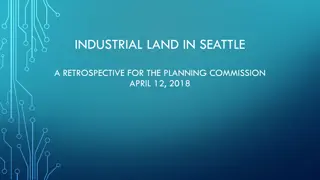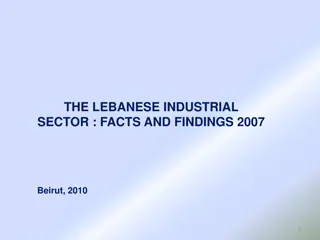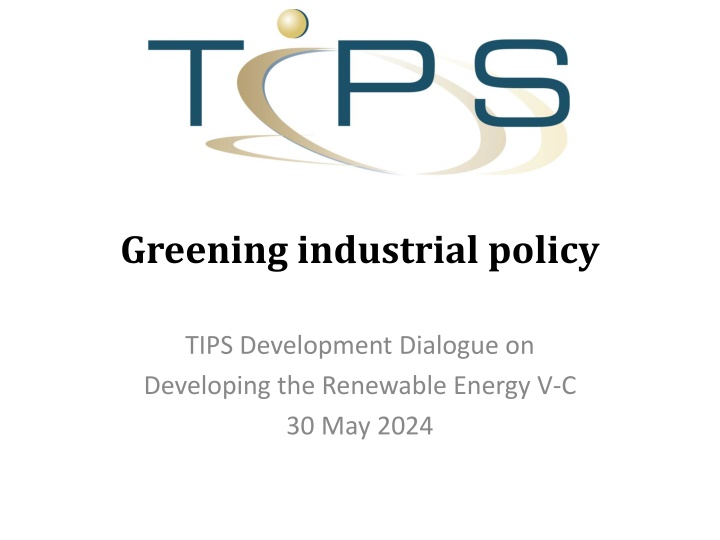
Key Issues for Industrial Policy and SA's Experience
Foundational presumption of industrial policy is that the market may not generate the desired outcomes, requiring proactive measures to address market imperfections and externalities, as seen in South Africa's industrial policy experience characterized by improved growth, diversified mining value chain, and challenges in manufacturing, employment, and income equality.
Download Presentation

Please find below an Image/Link to download the presentation.
The content on the website is provided AS IS for your information and personal use only. It may not be sold, licensed, or shared on other websites without obtaining consent from the author. If you encounter any issues during the download, it is possible that the publisher has removed the file from their server.
You are allowed to download the files provided on this website for personal or commercial use, subject to the condition that they are used lawfully. All files are the property of their respective owners.
The content on the website is provided AS IS for your information and personal use only. It may not be sold, licensed, or shared on other websites without obtaining consent from the author.
E N D
Presentation Transcript
Greening industrial policy TIPS Development Dialogue on Developing the Renewable Energy V-C 30 May 2024
Key issues for industrial policy Foundational presumption of industrial policy: Given existing economic relationships, the market will not generate the socially desired outcomes Proactive approach and support measures to building industrial capacity Also requires address market imperfections Externalities (in the case of climate change especially) For SA also ownership and income structures markets tend to reproduce inequalities Value chains analysis shows how interventions in specific phases within value chains affect upstream or downstream Downstream growth can increase demand for inputs Lower cost, higher quality and more reliable inputs can stimulate downstream growth Potential for conflict between commodity producers and downstream manufacturers While no standard definition, it includes Building industrial capacity and capabilities through Policies aimed at changes in production, ownership or spatial structure of the economy Typically geared to a value chain or industry, small business, or a region Addressing structural problems identified in the economy Different for different economies so SA cannot simply copy industrial policy in e.g. China, India or the EU Apartheid entrenched unique inequalities and extraordinary joblessness Unusually heavy dependence on mining exports for an upper middle income economy, even excluding East Asia
SAs industrial policy experience Some outcomes: Growth has improved over SA in 1980s, but slower than peer economies except at height of commodity boom in 2010s Mining value chain has successfully diversified away from gold, but still accounts for over half of goods exports, although it produces under 10% of GDP Falling share of manufacturing in the GDP; the only major manufacturing export industry is autos, followed by capital goods Services and horticulture have expanded relatively rapidly however with limited support from industrial policy Employment creation has kept up with population but not addressed apartheid backlogs Hovering around 40% of working-aged population compared to international norm of 60% Manufacturing employment at best stagnant Job creation almost exclusively in formal public and private services and in agriculture Income inequality remains amongst the worst in the world, although poverty mitigated by social grants and free basic services SA has been officially committed to economic reconstruction since Ready to Govern and the RDP Success in some areas, but no qualitative shift in structures of production or ownership Counterfactual: would likely have been worse without government efforts
adding the climate crisis The climate crisis adds two new aims: Improving resilience to direct impacts of the climate crisis Promoting less emissions-intensive production processes Key outcomes for greener industrial policy in SA: A successful energy transition, both to reduce emissions and to maintain export markets Improved resilience to extreme weather Mitigating the impacts of water shortages and droughts on producers Managing the fall out of rising costs of long-distance travel and some logistics most obvious impacts on tourism but could also affect horticulture Core challenge for industrial policy is to ensure producers have reliable, affordable and increasingly clean electricity Dual (and sometimes contradictory) industrial policy priorities in SA since 1994: Support more advanced and competitive manufacturing in order to increase local value added and reduce dependency on mining-based exports Promote inclusion through Higher levels of employment Support for small business and black ownership in general Support localisation through Procurement from the State Initiatives to promote local content (PSA & embedded into the master plans)
The energy transition Particularly important for SA due extraordinary coal dependency The coal value chain is a core part of the MEC SA more dependent on coal for electricity than other upper middle income economies Risk of barriers to key exports unless manage down coal dependency and emissions Coal-fuelled electricity system increasingly costly and unreliable Biggest disruption to Eskom and Sasol Also challenges around liquid fuels for transport Shift to EVs in key export markets for auto industry Range issues in SA, given distances between towns Core challenge for industrial policy in SA: is there a trade-off between greening the existing energy intensive industry or supporting structural change to cleaner industries.
Costs, benefits and risks Risks: Diffuse benefits for the majority of citizens, but tangible costs for some groups the classic recipe for mobilisation to lobby against change Reluctance to take on disruption slows the transition, raising costs for society in the medium term Unable to get affordable up-front financing, leading to undesirable delays and costs Costs: Writing off coal and downstream technologies and the associated profits and jobs Substantial up-front cost for new technologies (EV, renewable energy) even though ultimately pay for themselves Disruption of existing systems, both institutional and technical Institutional: e.g. tax, transport and licencing systems that benefit fossil fuels; Eskom electricity monopoly Technical: e.g. electricity grid, charging stations Benefits: More affordable and reliable electricity and vastly reduced fuel imports, generating new opportunities across the economy for both jobs and profits Maintain access to overseas markets, especially for metals and cars More decentralised and therefore more resilient electricity systems Spillovers for new technologies and potential for local production of some inputs
Aligning government Government does not use some of the key levers for industrial policy, especially infrastructure, education and standard setting of all kinds Disagreements within government (between departments, spheres and SOCs) No fast dispute-settlement resolution all major issues go to Cabinet, which is over-burdened Contestation aggravated by broader inequalities in society, which means policies often have very different impacts on different socio-economic groups How to ensure: Greater clarity about core objectives, instead of responding to lobbying by factional economic and political interests? Efficient consultation and dispute resolution between government agencies?
Conclusions - Managing costs, benefits and risks Structural change is inherently disruptive Established business lobbies for support, particularly where policies aim to disrupt seemingly stable and long-successful systems Approach has been to avoid ambitious, disruptive measures to avoid getting blamed for failure not so if maintain existing systems, however ineffective or even costly for society Need new systems that can drive innovation in part by managing risks and costs A particular challenge has been balancing support for existing companies against need for new kinds of production and ownership for more inclusive and dynamic growth A focus on exports and competitiveness is unlikely to expand employment sufficiently by itself, especially given the sharp slowdown in global markets in the past decade but it is a critical component of any economic policy Inclusive growth needs new industries, including green industries; new kinds of producers and new kinds of state support (amongst others in the social economy, community works, vastly scaled up support for labour-intensive industries, including the services) Importance of building and strengthening cost effective value chains that promote downstream industrial development Challenge will be even greater with climate change
Issues for consideration What is needed to build a stronger coalition to support a green industrial policy? What systemic changes would promote better alignment around economic development needs across the state? What are the top priorities for industrial policy in responding to the climate crisis?

